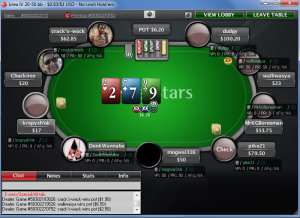 A HUD is a heads up display. Heads up displays are one of the primary functions of poker tracking software programs. A heads up display can tell you everything from how often a player raises to the frequency in which they fold to a 3-bet. Needless to say, HUDs can make any player’s life a whole lot easier. Virtually every winning online poker player uses a HUD to one extent or another, so it only makes sense that you too are utilizing all of the benefits that HUDs have to offer.
A HUD is a heads up display. Heads up displays are one of the primary functions of poker tracking software programs. A heads up display can tell you everything from how often a player raises to the frequency in which they fold to a 3-bet. Needless to say, HUDs can make any player’s life a whole lot easier. Virtually every winning online poker player uses a HUD to one extent or another, so it only makes sense that you too are utilizing all of the benefits that HUDs have to offer.
The real trick with HUDs is not using them, but instead using them correctly. As is the case with most aspects of poker, a HUD does have a slight learning curve. You will have no clue what anything means when you first start to use one, but before long you will be relying on it for a number of tough decisions that you are faced with hand after hand. HUDs can be used in tournament or cash game settings, though they are far more prevalent in the ring games. The problem with using a HUD in sit and gos is that you will often be working with small sample sizes. It is difficult to gauge the accuracy of any set of data if it is only over a handful of hands. If you are playing against a lot of the same players over and over again, however, a HUD can then also be useful in a sit and go environment. No matter what types of games you are playing, all HUDs have the same basic information that needs to be accurately interpreted.
Pre Flop HUD Stats
Pre flop play is when you will use your HUD the most. The vital HUD stats include PFR, AF, VP$IP and the number of hands played. These abbreviations stand for pre flop raise percentage (PFR), aggression factor (AF), and volume put money in the pot voluntarily (VP$IP). Next we are going to break down exactly what each one means.
PFR – The pre flop raise percentage is on a scale of 1-100. A player with a PFR of 17.8 will raise their hands pre flop 17.8% of the time. This is a very simple number to understand but should only be measured against like opponents. If you find that four players in a full ring game have a PFR of 12-14, but one player has a 6, you can safely assume that the player with a 6 is playing very tight. Likewise, a player with a PFR of 32 at this same table will be playing way too loose. A few hundred hands is generally enough to get an idea of how someone tends to play, though 1,000 hands will be much more conclusive.
AF – Aggression factor is a complicated number because it often means nothing at all in a nutshell. This number is usually based on a scale of 1-10. A very low number is abnormal, while a figure closer to 4 is about average. Again, this number is almost exclusively dependant on the game it is being applied to.
VP$IP - The VP$IP will tell you how often someone gets involved in pots of their own free will. This number takes into consideration all of the hands where a player puts in money when they were not required. For example, the small blind and big blind will put money in a pot, but it is a forced bet. As a result, the sb and bb do not have these wagers added to their VP$IP. If a player in the sb or bb made a raise or called any additional bets to see a flop, this would be considered voluntary. The VP$IP number of a solid TAG player will be around 3-7 digits higher than the PFR. For example, 22/18 (VP$IP/PFR) would be indicative of a strong player. They don’t play a ton of pots, but when they do, they are usually coming in for a raise.
Number of Hands – The number of hands is the most self-explanatory figure in the lot. Always take a look at the number of hands that you have on a player before you ever use their statistics when making a decision. If you only have 5-20 hands on a player, the data is likely to be inaccurate. As a general rule of thumb, 100-200 hands is a good starting point at which your numbers start to tell an accurate and reliable story.




1 Comment - Click Here to Speak Up